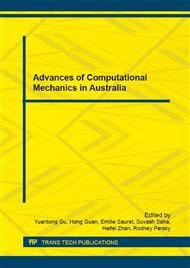p.205
p.211
p.217
p.225
p.231
p.237
p.245
p.251
p.258
Simulating Post Punching Behaviour of RC Slab-Column Connections Using a Micro Model
Abstract:
Punching shear is a common failure mode occurring at the slab-column connection region of a reinforced concrete (RC) flat plate. Progressive collapse of RC flat plates poses a significant scientific question on the post punching behaviour of such a structural system. The challenge lies in the complex interactions amongst various internal actions including large unbalanced moments and shear forces. Existing numerical models are unable to differentiate the influence of each individual action within the connection region after punching occurs. Therefore, a new numerical model is required to model these actions individually as well as to evaluate their interrelationships. This paper thus aims to propose a numerical method to investigate the structural response of RC slab-column connections by using a micro model, based on a representative post punching failure experiment. In the micro model, concrete is simulated using solid elements whilst the reinforcement is modelled with truss elements. In this micro model, the constitutive laws and failure criteria of materials play a crucial role in describing the model’s structural behaviour. A typical structural response is discussed and a calibration method is established. Ultimately this study is expected to facilitate the development of an effective, yet simplified numerical model for future progressive collapse simulation of slab-column connections.
Info:
Periodical:
Pages:
231-236
Citation:
Online since:
July 2016
Authors:
Price:
Сopyright:
© 2016 Trans Tech Publications Ltd. All Rights Reserved
Share:
Citation:


